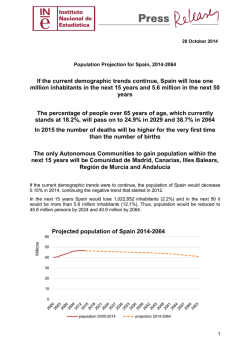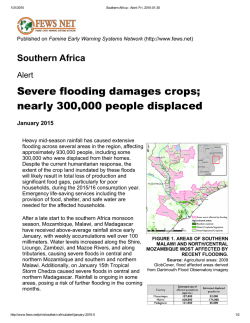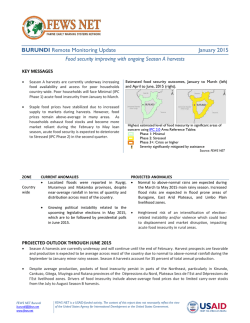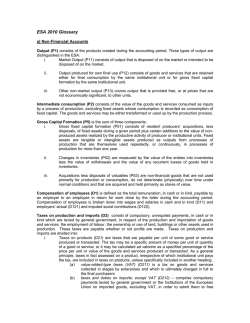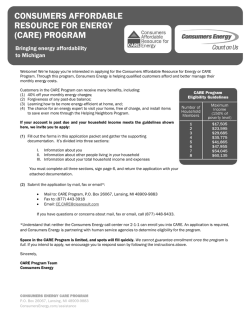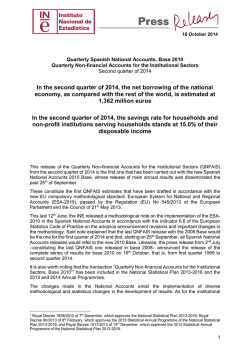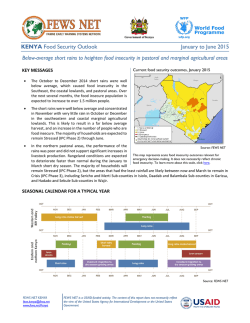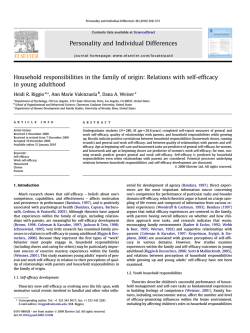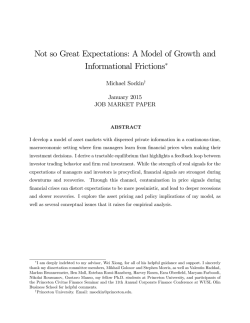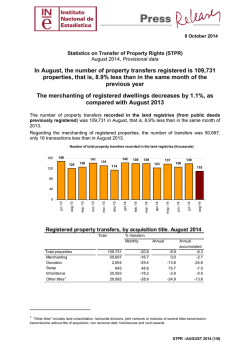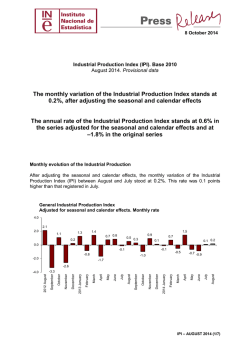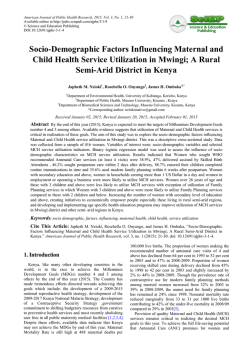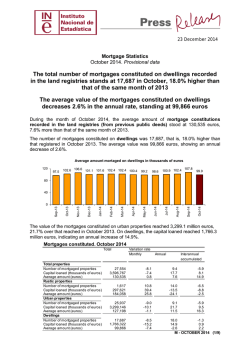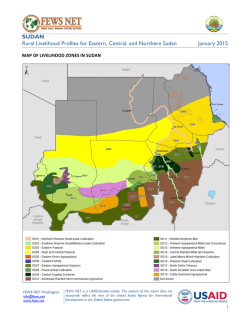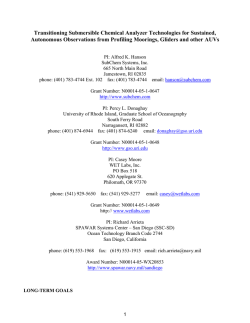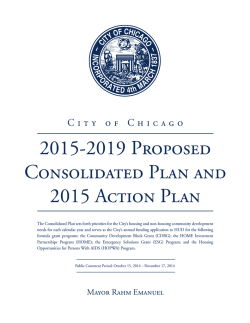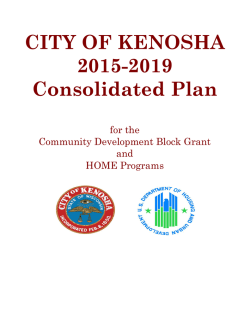
Household projection 2014-2029
28 October 2014 Household Projection 2014–2029 The INE presents the new statistical operation Household Projection 2014-2029 If the current trends are maintained, the number of households would stand at 19.2 millions in 2029, almost a million more than at present By Autonomous Community, the greatest growth rates would take place in Comunidad de Madrid, Región de Murcia and Andalucía. Only Castilla y León and Principado de Asturias would register a decrease in the number of households As an innovation, along with the Population Projections, the INE publishes today, for the first time, the Household Projection 2014-2029. This new statistical operation, included in the 20132016 National Statistical Plan and in the Annual Programme 20141, is designed to provide updated information on the number of households and to offer, every two years, a statistical of the future number of households according to size, over a 15-year period for the national total and by Autonomous Community and province. It was submitted to the Permanent Commission of the High Council on Statistics in their meeting of 20 May 2014. The projection reflects the result that would have the extension of the demographic trends and social behaviour patterns currently observed on the number of households. Likewise, the results of said operation are fully consistent with those of the Population Projections that the INE disseminates today, due to the way they are generated. According to this projection, the number of households resident in Spain would increase by 951,171 (5.2%) between 2014 and 2029, reaching a figure of 19,204,058. This would happen despite the drop of the population resident in households, that would decrease by 1,144,374 persons (2.5%) in said period. This is due to a reduction in the number of persons living in each household. Thus, the average size of the household would decrease from the current 2.52 persons to 2.34 persons per household in 2029. 1 Royal Decree 1658/2012, of 7 Decem ber, passing the 2013-2016 National Statistical Plan and Royal Decree 1017/2013, of 20 Decem ber, passing the Annual Programm e 2014. 1 Household Projection in Spain 2014-2029 Number of households on 1 January Absolute growth in five years 2014 18,252,887 326,108 0.36 2019 18,578,994 302,869 0.33 2024 18,881,863 322,194 0.34 2029 19,204,058 Year Average annual relative growth (%) Evolution of the number of households by size Between 2014 and 2029 smaller households (one or two persons) would continue growing, whereas bigger households would decrease, specifically those of five or more persons, thus keeping the trend of the past years. Projection of the number of households by size 2014-2029 41,640 47,119 18,252,887 19,204,058 1 person 4,480,391 5,711,125 1,230,734 27.5 2 persons 5,581,768 5,998,563 416,794 7.5 3 persons 3,852,223 3,752,375 -99,848 -2.6 4 persons 3,251,485 2,961,117 -290,368 -8.9 5 or m ore persons 1,087,019 780,877 -306,141 -28.2 2.52 2.34 -0.18 -7.3 Total households Average size 2014-2029 Growth Absolute Relative(%) Evolution of the rate of households by size 2014-2019 29.7% 30.6% 31.2% 24.5% 21.1% 19.5% 17.8% 15.4% 6.0% 1 person 2 persons 3 persons 2014 4 persons 4.1% 5 or more persons 2029 Those households where only one person lives would show a greater increase in the next 15 years, both in absolute and relative values. In 2029 the number of single-person households would reach 5.71 million households (29.7% of the total households), with an increase of 27.5% (1.23 millions more) as compared with the beginning of 2014. The number of persons living alone would go from 9.7% of the total population in 2014 to 12.7% in 2029. 2 Households formed by two persons would still be the most frequent type of household in 2029. They would reach a figure of 5.99 millions (31.2% of the total), with an increase of 7.5% (416,794 more) since 2014. On the other hand, households with three, four, five or more persons would maintain negative growth rates along the 2014-2029 period. Households formed by three persons would decrease the least. Households formed by five and more members would decrease from 1.08 millions in 2014 to 780,877 in 2029 (28.2% less). Evolution of the average size of household The average size of household would continue decreasing in the 2014-2019 period, in line with the trend observed in the last censuses (in 1970 the figure was of almost four persons). More specifically, it would decrease from 2.52 persons per household en 2014 to 2.34 in the year 2029. 2.86 2002 Projected evolution of the average size of household 20022029 2.76 2005 2.68 2008 2.60 2011 2.52 2014 2.48 2017 2.45 2.41 2.37 2.34 2020 2023 2026 2029 Household projection by Autonomous Community The number of households would increase in all Autonomous Communities along the 20142029 period, except in Castilla y León (–2.2%) and Principado de Asturias (–1.4%). In turn, the Autonomous Cities of Ceuta (24.0%) and Melilla (13.7%), Comunidad de Madrid (12.6%) and Región de Murcia (10.1%) would register growth rates higher than 10%. The average size of household would decrease in all Autonomous Communities along the period. Cantabria, Comunidad de Madrid and Galicia would register the greatest decreases, whereas Canarias, Illes Balears and Cataluña would register the slightest decreases. Regarding the number of single-person households, Comunidad de Madrid, Región de Murcia and the Autonomous City of Ceuta would register the greatest increases, higher than 40%. Aragón, La Rioja and Canarias would register the slightest increases (lower than 15%), whereas the Autonomous City of Melilla would be the only area where the number of singleperson households would decrease (–20.4%). 3 Porjected growth of the number of households 2014-2029 by Autonomous Community. Percentages Ceuta Melilla Madrid, Comunidad de Murcia, Región de Andalucía Navarra, Comunidad Foral de Balears, Illes Cantabria Castilla - La Mancha Canarias National Total Extremadura País Vasco Galicia Rioja, La Cataluña Aragón Comunitat Valenciana Asturias, Principado de Castilla y León 23.99 13.68 12.62 10.07 9.10 8.89 8.25 7.22 6.22 6.16 5.21 4.99 3.65 2.46 1.33 1.14 1.05 0.96 -1.36 -2.22 -4.0 1.0 6.0 11.0 16.0 21.0 Projection of the number of households by Autonomous Community 2014-2029 Total number of households 2014-2029 Growth 2014 National Total Andalucía 2029 Absolute Average size of household Relative(%) 2014 2029 % of singleperson households 2014 2029 18,252,887 19,204,058 951,171 5.21 2.52 2.34 24.5% 29.7% 3,149,346 3,435,979 286,633 9.10 2.65 2.42 22.2% 27.9% Aragón 538,690 544,366 5,676 1.05 2.43 2.29 26.6% 30.2% Asturias, Principado de 460,679 454,435 -6,245 -1.36 2.28 2.11 28.9% 34.2% Balears, Illes 440,987 477,360 36,372 8.25 2.51 2.43 24.1% 27.9% Canarias 809,216 859,087 49,871 6.16 2.60 2.51 23.4% 24.8% Cantabria 238,538 255,770 17,233 7.22 2.44 2.17 26.8% 34.3% 1,032,038 1,009,152 -22,885 -2.22 2.37 2.19 27.9% 32.9% 784,359 833,127 48,768 6.22 2.61 2.41 22.7% 27.1% Cataluña 2,944,905 2,978,602 33,697 1.14 2.49 2.38 24.6% 28.8% Comunitat Valenciana 1,999,020 2,018,262 19,241 0.96 2.46 2.32 25.7% 30.3% 431,174 452,708 21,533 4.99 2.51 2.29 24.7% 30.3% Galicia 1,074,642 1,101,082 26,439 2.46 2.54 2.28 23.8% 30.2% Madrid, Comunidad de Castilla y León Castilla - La Mancha Extremadura 2,499,704 2,815,148 315,444 12.62 2.52 2.27 25.1% 32.0% Murcia, Región de 531,035 584,500 53,465 10.07 2.74 2.49 20.1% 26.4% Navarra, Comunidad Foral de 250,704 272,986 22,282 8.89 2.51 2.29 26.0% 32.1% País Vasco 888,557 920,968 32,411 3.65 2.41 2.20 26.4% 33.1% Rioja, La 128,912 130,628 1,716 1.33 2.41 2.25 28.1% 31.4% Ceuta 25,476 31,588 6,112 23.99 3.29 2.88 15.7% 23.6% Melilla 24,902 28,309 3,407 13.68 3.32 3.30 16.9% 11.8% 4 Methodological note Household Projection 2014-2029 The Household Projection is a statistical operation compiled from the aggregate results of several statistical sources, elaborated and disseminated by the INE for the first time in 2014. It provides a statistical simulation of the number of future households in Spain, of each Autonomous Community and each province, and their distribution by size, would the demographic trends and social behaviour patterns currently observed be extended. Due to the way in which they are compiled, the results are totally consistent with the results of the Population Projections also disseminated by the INE. This operation will be published every two years, providing results regarding the next 15 years. This publication covers the 2014-2029 period. The necessary data is obtained from the use of municipal registers of the years prior to the year of compilation, which allows obtaining the tendencies that the population has of living in a certain type of household according to their sex, age and province of residence. These tendencies are calculated at least in two different moments, which allows the extrapolation of their behaviour in the future. The tendencies obtained are applied to the population figures projected for the future in such a way that it is possible to obtain a simulation of future households based on their recent behaviour. There is no international nor European regulation regarding household projections, therefore the possible projections compiled by other international bodies such as Eurostat or the United Nations, regarding households in Spain, would respond to their own purposes, methodologies and hypotheses. Thus, in general, these results would not coincide among one another nor with the results of this operation. In this first publication, the information is completed with the publication of the historical series corresponding to household estimates from 2002 to 2014. Definitions Household This is the person, or group of persons, who regularly reside in a main family dwelling. Family dwelling Dwelling intended to be inhabited by one or several persons who are not necessarily related by kinship and do not form a group. Size of the household Number of persons who constitute the household, classified as: households of size 1, of size 2, of size 3, of size 4 and of size bigger than 4. For further inform ation see INEbase-w w w .ine.es/ en/ w elcom e_en.htm w w w .ine.es/ prensa/ prensa_en.htm All press releases at: Press office: Telephone num bers: 91 583 93 63 / 94 08 – Fax: 91 583 90 87 - [email protected] Inform at ion Area: Telephone num ber: 91 583 91 00 – Fax: 91 583 91 58 – w w w .ine.es/ infoine 5
© Copyright 2025
